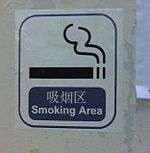Smoking in Singapore

Smoking in Singapore was first banned in buses, cinemas and theatres in September 1970, [1] and it was extended to indoor locations where it is frequented by most people on August 1977. After the King's Cross fire in 1987, smoking was banned in the Singapore MRT.[1]
On 1 July 2005, the ban was extended to bus interchanges and shelters, public toilets and public swimming complexes whereas from 1 July 2006, the ban was extended to coffeeshops and hawker centres.
On 1 July 2007, the ban was extended to entertainment nightspots, including pubs, bars, lounges, dance clubs, and night clubs.[2] The owner of the premises is legally responsible for the non-smoking of the customers.[2] The law allows for the construction of designated smoking rooms which can take up to 10% of the total indoor space, or outdoor smoking areas that do not exceed 20% of the outdoor refreshment area.[2]
On 1 January 2009, the ban was extended to all children's playgrounds, exercise areas, markets, underground and multi-storey carparks, ferry terminals and jetties. It was also extended to non-air-conditioned areas in offices, factories, shops, shopping complexes and lift lobbies,[3] and within 5 metres (16 ft) of entrances and exits.[4]
On 22 November 2010, netizens of Singapore supported the Towards Tobacco-Free Singapore online campaign. The campaign promotes a proposal (which was published in the British medical journal Tobacco Control) to prevent the supply of tobacco to Singaporeans born from the year 2000 which would result in a gradual phasing-out of tobacco in Singapore. The launch was put forward by a team consisting of a lung cancer surgeon, medical officers, a university professor and a civil servant.[5]
On 15 January 2013, the ban was extended to all common areas of the residential block including linkways from bus stops to residential blocks, void decks, corridors, stairwells, stairways and multi-purpose halls, in addition to covered walkways and linkways, all pedestrian overhead bridges, 5 m from the bus stops and hospital outdoor compounds. However, the residential block smoking ban was not mandatory as there are more people smoking except when during wakes or funerals.
Smokers found flouting the rules are fined a minimum 200 Singapore dollars[6] up to a maximum of S$1000 if convicted in court,[6] while the managers of the establishments are fined S$200 for a first offence, and S$500 for a subsequent offence.[2] Singapore is famous for being clean, with enforced penalties for littering;[7] cigarette butt littering is one of the greatest high-rise littering problems.[8]
Staff working for certain government sectors, such the National Recycling Programme, are not allowed to smoke while carrying out their duties.[9]
See also
References
- 1 2 "Public Health Policies: Smoking Ban". Ministry of the Environment and Water Resources, Singapore Government.
- 1 2 3 4 "Going Smoke-Free: a step forward (PDF)" (PDF). National Environment Agency of Singapore.
- ↑ Maji, Hasnita (29 February 2008). "Smoking ban to be extended to more areas from January 2009". Channel NewsAsia.
- ↑ "Campaigns: Smoking Ban Extension". National Environment Agency, Government of Singapore.
- ↑ "Towards Tobacco-Free Singapore online campaign launched". Towards Tobacco-Free Singapore.
- 1 2 "Details of Smoking Ban in Entertainment Outlets". National Environment Agency of Singapore.
- ↑ "Singapore bans outdoor smoking". news24/AFP. 4 July 2006. Retrieved 21 October 2016.
- ↑ "High Rise Flat Littering of Cigarette Butts". Smoke For What.
- ↑ "Singapore's National Environment Agency Responded Fast to Feedback". Smoke For What. Retrieved 21 October 2016.
External links
- FAQs on Smoking Ban in Public Places National Environment Agency of Singapore
- For Public to Voice out on Smoking Issues Smoke For What (Based in Singapore)
- Information on the proposal to prevent supply of tobacco to Singaporeans born from year 2000 Towards Tobacco-Free Singapore
.svg.png)